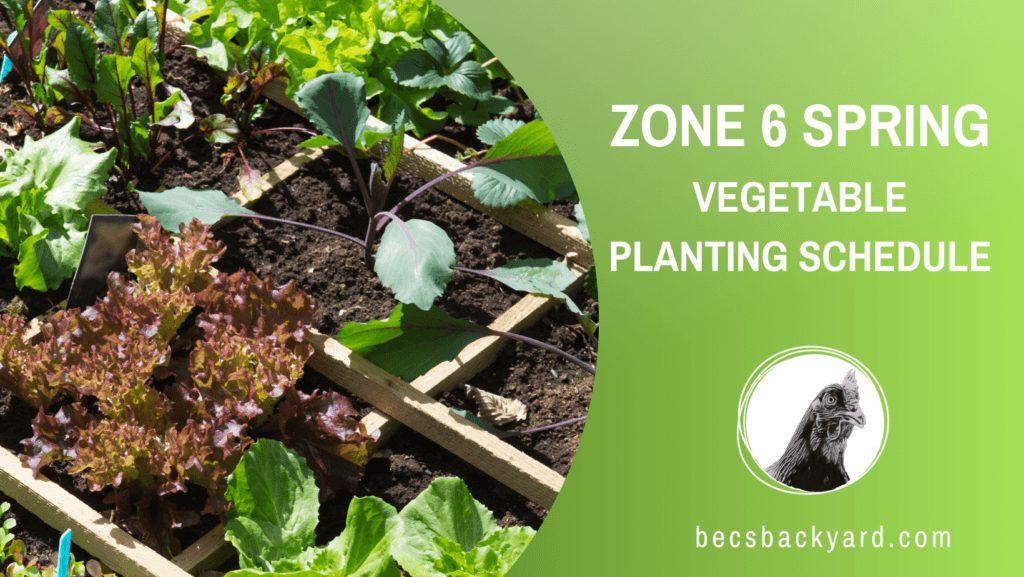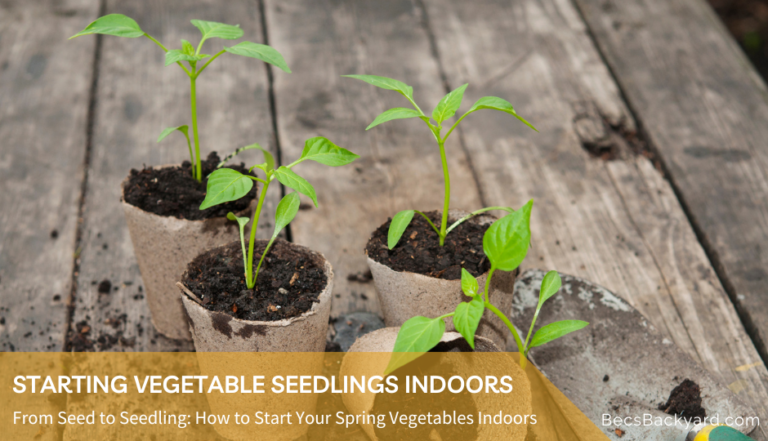Zone 6 Spring Vegetable Planting Schedule: Your Guide to a Flourishing Garden

Winter is ending it is now time to look at your Zone 6 Spring Vegetable Planting Schedule. Gardeners in Zone 6 can mark the end of chilly days by beginning to plant a vibrant and productive vegetable garden. As spring ushers in longer days and warmer temperatures, starting a vegetable garden becomes a rewarding endeavor that not only offers the satisfaction of growing your own food but also contributes to a sustainable lifestyle. The key to a successful harvest is understanding the specific growing window of Zone 6, which typically spans from mid-March to mid-November, allowing for a wide variety of vegetables to thrive.
Before embarking on planting, it’s essential for gardeners to recognize the significance of the last frost date, which generally falls around mid-April for Zone 6. This date guides the scheduling of seed starting and transplanting, ensuring that plants aren’t exposed to damaging cold. A combination of indoor seed starting and direct seeding outdoors, once the threat of frost has passed, can lead to an abundant and diverse vegetable garden. Seasonal planning is vital, with early spring being ideal for cool-season crops and late spring suitable for warm-season varieties that require more heat.
Selecting the right vegetables to plant is a crucial step for Zone 6 residents. Early spring allows for the planting of lettuce, peas, radishes, and spinach, which can tolerate the cooler start of the season. As the spring progresses and the soil warms, gardeners can shift their focus to planting tomatoes, peppers, cucumbers, and beans. Root vegetables like carrots and beets also do well when planted in spring, readying for a summer harvest. Adhering to a well-thought-out planting schedule maximizes both the garden’s yield and the gardener’s enjoyment.
Zone 6 Spring Vegetable Planting Schedule | Understanding Zone 6
In the context of gardening, Zone 6 is a category within the USDA Hardiness Zones system that specifies the climate and ideal planting times for the region. It encompasses parts where specific weather patterns and frost dates are critical for successful plant cultivation.
Climate and Weather Patterns
The climate in Zone 6 is typically characterized by cold winters and moderate summers. While weather can vary within the zone, gardeners can expect a shorter growing season in comparison to zones located further south. February is often the final period of deep winter, with March signaling the advent of spring. April and May generally bring milder temperatures and increased sunshine, pivotal for seedling growth.
Last Frost Dates
For gardeners in Zone 6, the last frost date is a crucial indicator of when to transition from indoor seed starting to outdoor planting. These dates can vary across different areas within Zone 6:
- Early Zone 6: Last frost dates can occur as early as late March.
- Mid to Late Zone 6: More commonly, gardeners see the last frost from mid-April to early May.
It is advised for gardeners to monitor local weather forecasts and historical frost date data to pinpoint the optimal planting window in their specific area within Zone 6.

Starting Seeds Indoors
When planning for a Zone 6 vegetable garden, initiating the growing season with indoor seed starting gives plants a healthy head start. This preparatory step can be the difference between a good harvest and a great one.
Selecting Seeds
Individuals should select seeds based on the climate and the last frost date of Zone 6. Most vegetables will benefit from being started indoors, but it’s essential to prioritize:
- Cold-sensitive plants: such as tomatoes and peppers.
- Plants with longer maturation times: providing them with the extra growth period they need.
Choose high-quality, disease-resistant seeds from reputable sources to increase the chances of successful germination and healthy plant development.
Seed Starting Techniques
Seed starting requires precision and attention to detail:
- Containers: Utilize clean containers with drainage holes. Seed starting trays, peat pots, or even homemade paper pots can be suitable.
- Soil: Opt for a sterilized, seed-starting mix that’s light and nutrient-rich.
- Planting Depth: Plant seeds at a depth approximately three times their diameter.
- Moisture: Keep the soil consistently moist but not waterlogged.
- Temperature: Most seeds require a temperature between 65-75°F (18-24°C) for optimal germination.
A popular method includes the use of a heating mat to maintain a constant soil temperature and the application of plastic covers to retain humidity.
Indoor Seed Care
Proper care is crucial for the development of seedlings:
- Light: Seedlings need ample light, about 14-16 hours per day. Grow lights should be positioned a few inches above the plants and raised as they grow.
- Watering: Use a watering can with a gentle sprinkle or a spray bottle to avoid dislodging seeds or damaging young plants.
- Thinning: Once seedlings develop their second set of leaves, thin them to prevent overcrowding.
- Hardening off: Gradually acclimate seedlings to outdoor conditions by placing them outside for a few hours each day, extending the time gradually over a week.
Monitoring and adjusting these conditions will support the tender seedlings until they are robust enough for transplanting outdoors following the last frost.
Zone 6 Spring Vegetable Planting Schedule & Calendar
Zone 6 gardeners must heed the last frost date, typical around May 1st, to determine the appropriate timing for spring plantings. This schedule leverages the frost date to outline when to plant for optimal growth.
Early Spring Planting
In early spring, gardeners should prioritize starting seeds indoors to prepare for the transplanting period. For crops like tomatoes and peppers, initiating seeds indoors around March allows them sufficient time to mature.
Vegetables to start indoors in March:
- Tomatoes
- Peppers
Mid-Spring Transplanting
After the danger of frost has passed, near the beginning of May, gardeners can begin to transplant seedlings outdoors. This is the period when soil temperature starts to warm up, accommodating the root growth of transplanted fauna.
Seedlings to transplant in May:
- Tomatoes (after May 10th)
- Peppers (after May 10th)
- Broccoli (first week of May)

Zubebe 320 Pack 3.15 Inch Square Peat Pots
Perfect for getting seedlings started indoors ready for transplanting as soon as the last frost has been and gone. The square shape allows for good root formation and the material that it is made from can be planted directly into the ground and it will breakdown in the soil. This means that there is no disruption or damage to the seedling roots.
FIND ON AMAZONLate Spring Direct-Sowing
By late May to early June, when the soil has warmed adequately, it’s time to directly sow seeds into the garden. Crops that prefer warmer soil and are vulnerable to frost can be sown at this time ensuring a better germination rate.
Vegetables to direct sow from late May to early June:
- Beans
- Corn
- Squash
- Cucumbers
Zone 6 Plant Selection
In Zone 6, the spring planting schedule opens up a diverse opportunity to grow a range of vegetables that thrive in mild to warm temperatures before the heat of summer sets in.
Leafy Greens
Leafy greens such as lettuce, spinach, and kale are ideal for early spring planting in Zone 6. These vegetables can be sown directly into the garden as soon as the soil can be worked. Gardeners should aim for:
- Lettuce: Sow every two weeks for a continuous harvest.
- Spinach: Plant as early as the ground thaws.
- Kale: Begin planting up to six weeks before the last frost date.
Root Vegetables
Root vegetables are another group that can be successfully planted in the spring for Zone 6 gardens. They enjoy the cool start to the season and do well when planted early. Varieties to consider include:
- Onions: Start indoors or plant onion sets as soon as the ground is workable.
- Beets and Carrots: Direct sow beets and carrots four weeks before the last expected frost.
- Radishes: Fast-growing radishes can be sown as soon as the soil is ready and harvested in as little as four weeks.
Summer Crops
Planting for tomatoes, peppers, cucumbers, and squash should take into account the last frost date, as these warm-season crops will not tolerate frost. For best results:
- Tomatoes and Peppers: Start indoors 6-8 weeks before the last anticipated frost and transplant after all danger of frost has passed.
- Cucumbers and Squash: Sow seeds directly into the garden no earlier than two weeks before the last expected frost date.
By selecting the appropriate variety of each vegetable and adhering to the Zone 6 planting schedule, gardeners can maximize their yield throughout the growing season.
Care and Maintenance for Vegetables
Proper care and maintenance are crucial for a bountiful vegetable harvest in Zone 6. A diligent gardener focuses on optimal watering and feeding practices, along with managing pests and diseases efficiently.
Watering and Feeding
Vegetables require consistent moisture, especially during dry spells. Watering should be done early in the morning to allow foliage to dry, reducing disease risk. Drip irrigation or a soaker hose can provide deep watering that encourages strong root growth. An ideal schedule entails 1 inch of water per week, either from rainfall or irrigation.
When it comes to feeding, vegetables benefit from well-balanced nutrients. Incorporate a layer of compost or well-rotted manure into the planting area before sowing or transplanting. A side dressing of a balanced, slow-release fertilizer midseason can promote vigorous growth and a fruitful harvest.
Pest and Disease Management
Pests in the garden can be managed through a combination of cultural practices and interventions:
- Regular inspection of plants for early detection
- Removing infested foliage or plants to prevent spread
- Introducing beneficial insects that prey on pests
- Using physical barriers like row covers
Diseases often stem from environmental conditions and can be mitigated by:
- Ensuring proper plant spacing for air circulation
- Rotating crops annually to prevent soil-borne diseases
- Utilizing disease-resistant vegetable varieties
- Applying organic fungicides if necessary and as directed
A gardener who employs careful watering and feeding practices while remaining vigilant against pests and diseases will maintain a thriving vegetable garden through the growing season.
Frequently Asked Questions
In USDA Zone 6, timing and plant selection are decisive factors for a successful spring vegetable garden. Here are some common questions to ensure gardeners are well-informed and ready for the planting season.
When is the optimal time to begin planting a spring vegetable garden in Zone 6?
Gardeners in Zone 6 can typically commence planting as early as March. However, they should be mindful of the last frost date which can occur as late as early May.
Which vegetables are known to thrive well in Zone 6 during the spring season?
Vegetables like tomatoes, peppers, and cucumbers are known to do very well in Zone 6, given that they are planted after the danger of frost has passed and the soil has warmed sufficiently.
What early-spring vegetables should be started indoors in March for Zone 6?
Broccoli, cabbage, and cauliflower are among the vegetables that should be started indoors in March for later transplanting outdoors in Zone 6.
How does the planting schedule differ between Zone 6a and Zone 6b?
Zone 6a experiences colder temperatures than 6b, resulting in a slightly later start to the planting season. Gardeners in Zone 6b can start planting earlier by a couple of week, depending on the year’s specific weather patterns.
Can you suggest a list of flowers suitable for a Zone 6 spring vegetable garden companion planting?
Flowers such as marigolds, nasturtiums, and calendula serve well as companions in a Zone 6 spring vegetable garden by deterring pests and attracting beneficial insects.
What is a comprehensive spring planting guide or schedule for Zone 6b specifically?
For Zone 6b, a comprehensive spring planting guide includes starting seeds indoors in February to March, followed by transplanting outdoors in April to May, after the last frost date. Cold-hardy vegetables can be sown directly into the soil as soon as it is workable.








